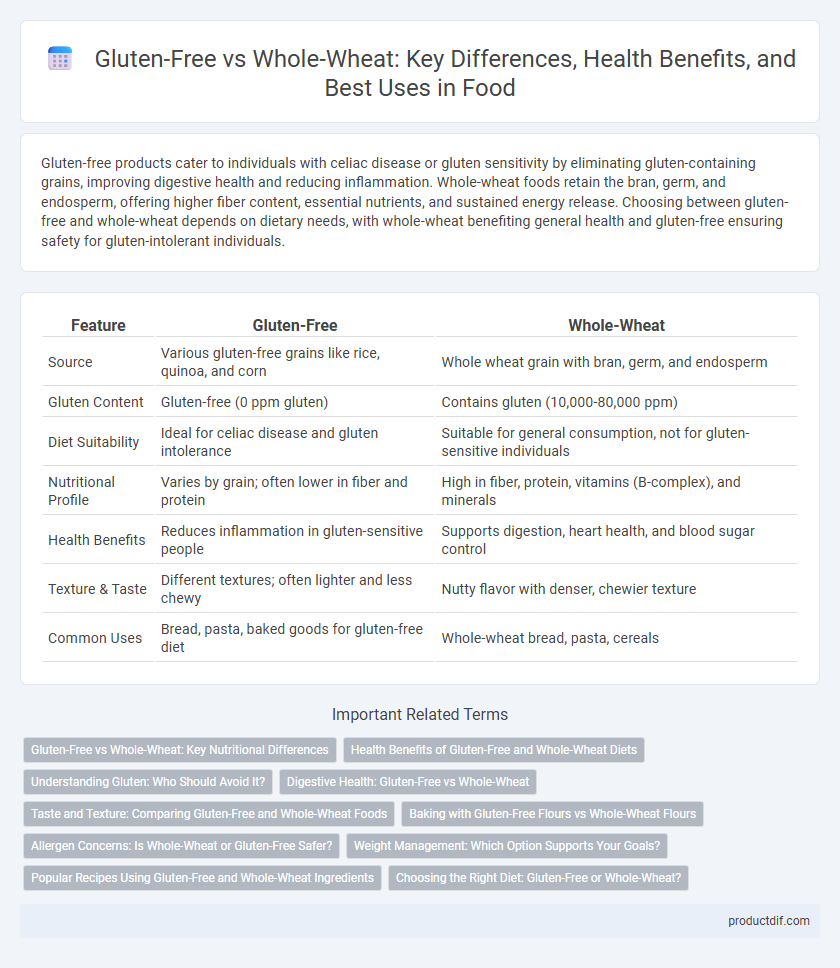Gluten-free products cater to individuals with celiac disease or gluten sensitivity by eliminating gluten-containing grains, improving digestive health and reducing inflammation. Whole-wheat foods retain the bran, germ, and endosperm, offering higher fiber content, essential nutrients, and sustained energy release. Choosing between gluten-free and whole-wheat depends on dietary needs, with whole-wheat benefiting general health and gluten-free ensuring safety for gluten-intolerant individuals.
Table of Comparison
| Feature | Gluten-Free | Whole-Wheat |
|---|---|---|
| Source | Various gluten-free grains like rice, quinoa, and corn | Whole wheat grain with bran, germ, and endosperm |
| Gluten Content | Gluten-free (0 ppm gluten) | Contains gluten (10,000-80,000 ppm) |
| Diet Suitability | Ideal for celiac disease and gluten intolerance | Suitable for general consumption, not for gluten-sensitive individuals |
| Nutritional Profile | Varies by grain; often lower in fiber and protein | High in fiber, protein, vitamins (B-complex), and minerals |
| Health Benefits | Reduces inflammation in gluten-sensitive people | Supports digestion, heart health, and blood sugar control |
| Texture & Taste | Different textures; often lighter and less chewy | Nutty flavor with denser, chewier texture |
| Common Uses | Bread, pasta, baked goods for gluten-free diet | Whole-wheat bread, pasta, cereals |
Gluten-Free vs Whole-Wheat: Key Nutritional Differences
Gluten-free products often lack the fiber, vitamins, and minerals found in whole-wheat foods, which are rich in nutrients like B vitamins, iron, and magnesium. Whole-wheat contains gluten, a protein that supports dough elasticity and provides a denser texture, while gluten-free alternatives typically rely on refined starches and flours that may be lower in protein and fiber. Choosing between gluten-free and whole-wheat depends on dietary needs, with whole-wheat promoting digestive health and gluten-free catering to those with celiac disease or gluten sensitivities.
Health Benefits of Gluten-Free and Whole-Wheat Diets
Gluten-free diets benefit individuals with celiac disease or gluten intolerance by reducing inflammation and promoting gut health. Whole-wheat diets provide essential nutrients like fiber, vitamins B and E, and antioxidants that support heart health and digestive function. Both dietary approaches contribute to improved wellness depending on individual health needs and conditions.
Understanding Gluten: Who Should Avoid It?
Gluten is a protein found in wheat, barley, and rye that can cause adverse reactions in individuals with celiac disease or non-celiac gluten sensitivity. Whole-wheat products contain gluten, making them unsuitable for those who require a gluten-free diet for medical reasons. Choosing gluten-free alternatives helps prevent gastrointestinal symptoms and promotes overall health for sensitive individuals.
Digestive Health: Gluten-Free vs Whole-Wheat
Whole-wheat contains high levels of dietary fiber, which supports digestive health by promoting regular bowel movements and feeding beneficial gut bacteria. Gluten-free diets can alleviate symptoms for those with gluten intolerance or celiac disease but may lack fiber if not carefully planned. Choosing whole-wheat products can enhance gut health, while gluten-free options require mindful inclusion of alternative fiber sources to maintain digestive balance.
Taste and Texture: Comparing Gluten-Free and Whole-Wheat Foods
Gluten-free foods often have a lighter, crumbly texture and a mild taste that can vary depending on the alternative flours used, such as rice or almond flour. Whole-wheat products feature a denser, chewier texture with a nuttier, richer flavor due to the presence of bran and germ components. The choice between gluten-free and whole-wheat foods significantly impacts the sensory experience, with whole-wheat typically offering more complexity in both taste and mouthfeel.
Baking with Gluten-Free Flours vs Whole-Wheat Flours
Baking with gluten-free flours like almond, rice, or coconut requires precise ingredient ratios and binders such as xanthan gum to mimic the elasticity provided by gluten in whole-wheat flours. Whole-wheat flour contains bran and germ, contributing to a denser texture and richer flavor, while gluten-free alternatives often necessitate blending multiple flours to achieve similar moisture and crumb structure. Understanding the protein content variations between gluten-free and whole-wheat flours is essential for adjusting leavening agents and hydration levels to optimize baking outcomes.
Allergen Concerns: Is Whole-Wheat or Gluten-Free Safer?
Whole-wheat contains gluten, which triggers allergic reactions and autoimmune responses such as celiac disease in sensitive individuals, making gluten-free options safer for those with gluten intolerance or wheat allergies. Gluten-free products eliminate this risk but may contain other common allergens like nuts or soy, requiring careful label scrutiny. For individuals without gluten sensitivity, whole-wheat offers nutritional benefits including fiber and essential nutrients, yet allergen concerns prioritize gluten-free options as safer for allergy management.
Weight Management: Which Option Supports Your Goals?
Gluten-free diets often lack fiber, which can slow metabolism and hinder weight management, while whole-wheat products provide high fiber content that promotes satiety and aids digestion. Whole-wheat's complex carbohydrates support steady blood sugar levels, reducing hunger spikes and helping control calorie intake. Selecting whole-wheat over gluten-free options can enhance weight management through improved nutrient density and digestive health.
Popular Recipes Using Gluten-Free and Whole-Wheat Ingredients
Popular recipes using gluten-free ingredients often feature almond flour, coconut flour, and quinoa, which cater to those with gluten intolerance or celiac disease. Whole-wheat recipes capitalize on the nutty flavor and higher fiber content of whole-wheat flour, commonly found in breads, pastas, and muffins, enhancing nutritional value. Both gluten-free and whole-wheat options are staples in health-conscious cooking, accommodating diverse dietary needs while maintaining taste and texture.
Choosing the Right Diet: Gluten-Free or Whole-Wheat?
Choosing between gluten-free and whole-wheat diets depends on individual health needs and dietary goals. Gluten-free diets are essential for people with celiac disease or gluten sensitivity, eliminating gluten proteins found in wheat, barley, and rye to prevent digestive and immune-related issues. Whole-wheat products provide higher fiber, vitamins, and minerals compared to refined grains, supporting digestion and heart health but may trigger symptoms in gluten-sensitive individuals.
gluten-free vs whole-wheat Infographic

 productdif.com
productdif.com